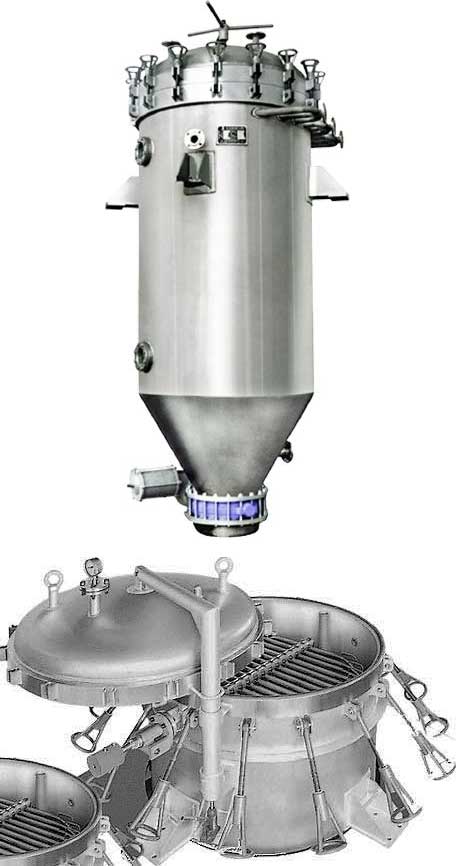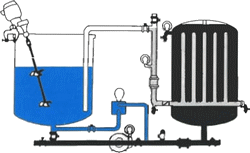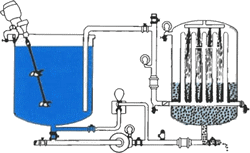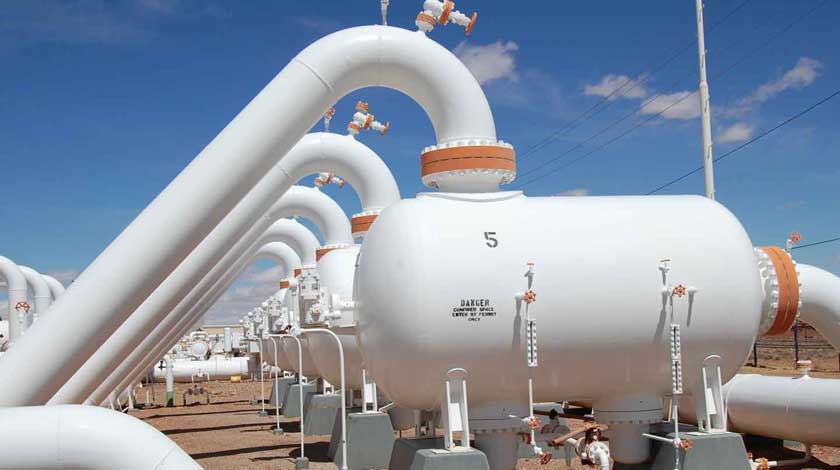 |
Pressure Leaf Filter |
Pressure Leaf Filters, in vertical or horizontal configurations, provide excellent removal of suspended solids from a field and are most commonly used in the filtration of crude oil, bleached oil, winterized oil, and nickel catalysts.
A wide range of filter vessel sizes is available, in both carbon steel and stainless
steel, as well as various exotic materials.
Every situation is different, and every system has its own characteristics; all these parameters
can result in a complex decision-making process.

Typical horizontal Leaf Filter
Operating principle
In a vertical pressure leaf filter, the filtration process begins almost immediately after the start of the filtration cycle. Solid particles form a filter layer on the fine outer mesh of the filter leaves. This process, also known as cake formation, ensures that all filterable solids are removed from the slurry. The clear filtrate flows through the vertically mounted, double-sided filter leaves and into a horizontally mounted outlet manifold.
Because the leaves filter on both sides, a large filter surface can be achieved in a relatively small vessel. Each leaf consists of several layers of stainless steel mesh, with the outer layers of fine mesh acting as the filter medium and the middle layer facilitating the drainage of the filtrate. The remaining layers serve as support for the filter medium.
A fully shielded inlet ensures that the solids in the incoming feed remain in suspension and that
cake formation on the filter media remains undisturbed.
The filtration cycle ends once the maximum pressure and/or cake thickness is reached. The unfiltered
oil remaining in the filter tank is transferred to an intermediate vessel for recirculation of the
filtration process.
The Typical Filtration Process
Fundamentals of Operation
A filter aid from the filter area is added to the precoat vessel, which is filled with clear liquid or filter process fluid. The slurry is stirred until well mixed.

The slurry is now re-circulated through the filter after venting all air. This will deposit a uniform layer of precoat (filter aid) on each filter leaf. A certain flow rate per hour (depending on the process fluid) is necessary for an adequate solution.

A The unfiltered process liquid is pumped to the filter. The filtrate is directed to process or storage and filtration continued until a full cake is formed or flow diminishes. If the solids are slimy in nature it might be nessesary to inject a filteraid into the main feed line by means of a proportining pump. this is a commom practice called body feeding.

When the filter is ready for cleaning the unfiltered heel in the tank is simply allowed to drain from the vessel with the cake or is blown back to the feed tank by air pressure. Releasing some air trought the leaves also serves to hold the cake in place for dry cake discharge.

Drain valves are opened and the cake is washed from the leaves by means of water jets. This flushing action can be abolished by a built sluicing header, air or steam pressure or manual rinsing.

Leaf Elements
The Heart of the Filter
Filter leaves are filter elements recommended for pressure leaf filters. Generally, 10 to 60 leaves are stacked in the filter. These form the heart of the filter and are the most critical components of pressure leaf filters. They are suitable for both vertical and horizontal pressure leaf filters.
Each filter leaf typically consists of five layers of woven stainless steel mesh (two layers of fine mesh, two layers of support mesh, and one layer of drainage mesh). All mesh layers are connected by a tubular frame and are made leak-proof by machine riveting or bolting for long life.
The weave type is usually woven stainless steel mesh and available in various shapes and mesh sizes.

Summary..Pressure leaf filters are closed, automatic separation devices for solids and liquids and can operate with various filter aids. They are used for decolorization, filtration of pharmaceutical oils, crystallization and separation processes, and in the production of oil, grease, and chemicals.
Reference(s)..
johannesfiltration.com
www.hankefilters.com
Related Post(s)

Scrubbers are air pollution control devices that use liquid to remove particulate matter or gases from an industrial exhaust or flue gas stream...